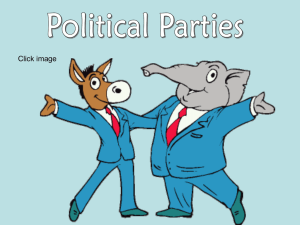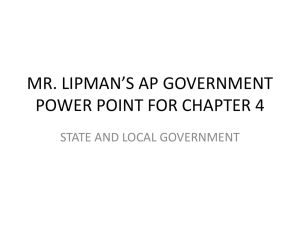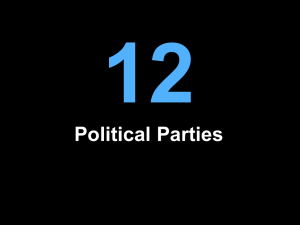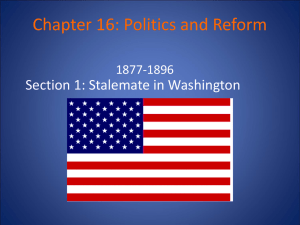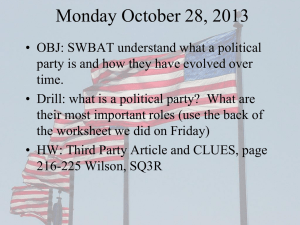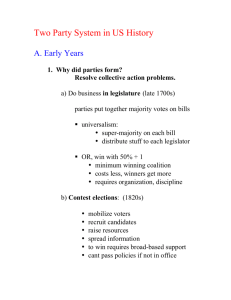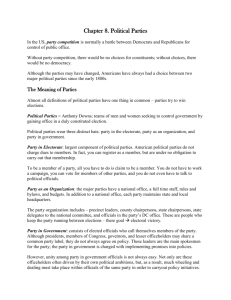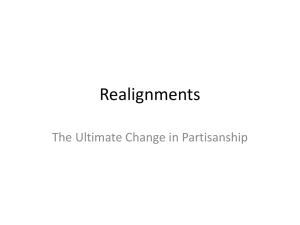Chapter 7 Political Parties: Essential to Democracy
advertisement
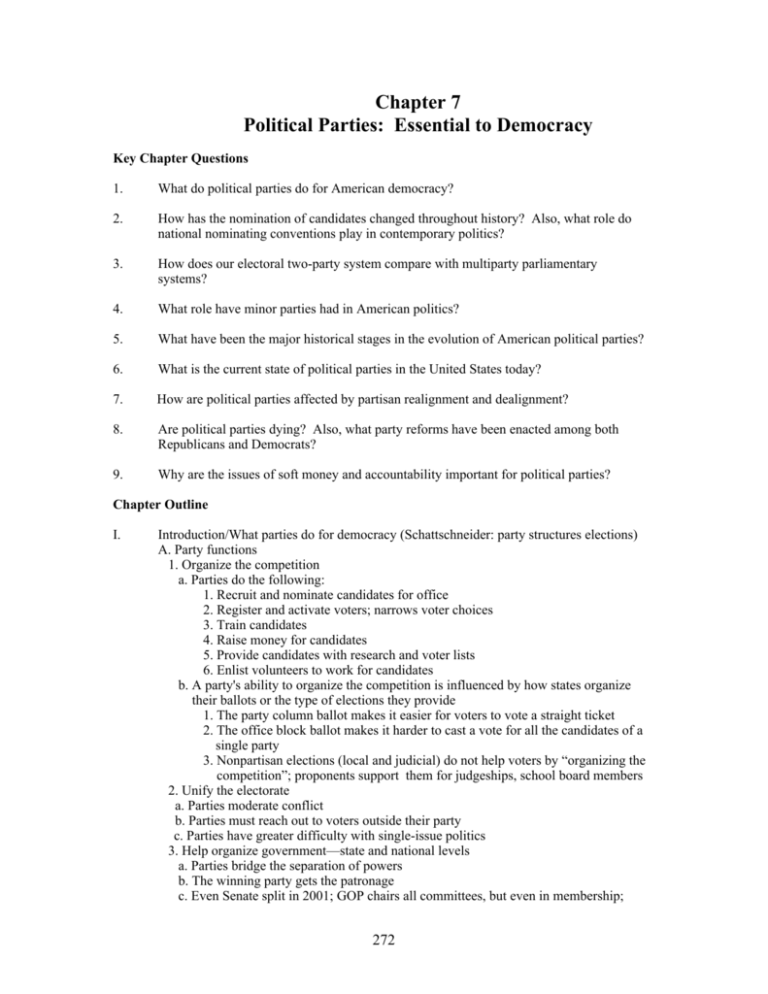
Chapter 7 Political Parties: Essential to Democracy Key Chapter Questions 1. What do political parties do for American democracy? 2. How has the nomination of candidates changed throughout history? Also, what role do national nominating conventions play in contemporary politics? 3. How does our electoral two-party system compare with multiparty parliamentary systems? 4. What role have minor parties had in American politics? 5. What have been the major historical stages in the evolution of American political parties? 6. What is the current state of political parties in the United States today? 7. How are political parties affected by partisan realignment and dealignment? 8. Are political parties dying? Also, what party reforms have been enacted among both Republicans and Democrats? 9. Why are the issues of soft money and accountability important for political parties? Chapter Outline I. Introduction/What parties do for democracy (Schattschneider: party structures elections) A. Party functions 1. Organize the competition a. Parties do the following: 1. Recruit and nominate candidates for office 2. Register and activate voters; narrows voter choices 3. Train candidates 4. Raise money for candidates 5. Provide candidates with research and voter lists 6. Enlist volunteers to work for candidates b. A party's ability to organize the competition is influenced by how states organize their ballots or the type of elections they provide 1. The party column ballot makes it easier for voters to vote a straight ticket 2. The office block ballot makes it harder to cast a vote for all the candidates of a single party 3. Nonpartisan elections (local and judicial) do not help voters by Òorganizing the competitionÓ; proponents support them for judgeships, school board members 2. Unify the electorate a. Parties moderate conflict b. Parties must reach out to voters outside their party c. Parties have greater difficulty with single-issue politics 3. Help organize governmentÑstate and national levels a. Parties bridge the separation of powers b. The winning party gets the patronage c. Even Senate split in 2001; GOP chairs all committees, but even in membership; 272 4. Translate preference into policy a. A particular party winning an election does not change the broad orientation of government b. Parties have only limited success in setting the course of national policy c. American system is candidate-centered; not a European Òresponsible partyÓ system d. Parties have gained political power through Òsoft moneyÓ 5. Provide loyal opposition B. The nomination of candidates 1. The legislative caucus was the earliest method used; the legislators in each party met separately to nominate candidates 2. In the 1820s, the mixed caucus brought in delegates from districts in which the party had no elected legislators 3. Party conventions were instituted during the 1830s and 1840s; delegates selected the party standard-bearers, debated and adopted a platform, and built party spirit 4. In the direct primary election, people could vote for the party's nominees for office 5. In states with open primaries, any voter, regardless of party, can participate in whichever primary he or she may choose; note California/Wisconsin use of blanket primary system; note that system declared unconstitutional in 2000 6. In states with closed primaries, only persons already registered in a party may participate 7. Direct primaries have diminished influence of political party leaders 8. Iowa uses the caucus system 9. In a few states, conventions still play roles in the nominating process (Connecticut and Utah) 10. Signatures on a nomination petition still possibleÑRoss Perot in 1992 11. Minor parties can functionÑVentura in 1998, Nader in 2000 C. Party Systems 1. United States' electoral two-party system versus multiparty parliamentary systems 2. United States' winner-take-all system versus proportional representation in multiparty systems (see insert on IsraelÕs coalition government) 3. United States' two-party system tends to create centrist parties versus influence of extremists in multiparty systems 4. Two-party systems lead to stable governments versus multiparty systems make governments unstable (coalitions form and collapse) D. Minor Parties: persistence and frustration 1. Two basic types of minor parties a. Those that arise around a candidate (T. Roosevelt, G. Wallace, Perot, Buchanan) b. Those that are organized around an ideology (Communist, Libertarian, Prohibition) 2. Minor parties have had an indirect influence by drawing attention to controversial issues and by organizing groups; Also criticized as ÒspoilersÓ (Nader diverting votes from Gore in 2000) II. A brief history of American political parties A. Our first parties 1. Parties arose out of the need to organize officeholders who shared their views so that government could act 2. Alexander Hamilton built an informal Federalist party 3. Jefferson opposed the administration's economic policies, and when he left the cabinet, many joined him, forming a group later known as Republicans, then as Democratic-Republicans, then as Democrats B. Realigning Elections 1. Definition 273 a. Realigning elections are turning points that define the agenda of politics and the Alignment of voters within parties during periods of historic change b. Characteristics 1. Intense electoral involvement by the voters 2. Disruptions of traditional voting patterns 3. Changes in the relations of power within the community 4. The formation of new and durable electoral groups 2. Four realigning elections (each realignment lasts roughly 36 years) a. 1824: Andrew Jackson and the Democrats b. 1860: The Civil War and the rise of the Republicans c. 1896: A Party in transition d. 1932: Franklin Roosevelt and the New Deal alignment (Keynesian economics) C. Divided government 1. Since 1953, we have had divided government twice as often as we have had one party in control of both legislative and executive branches 2. Today, the rise of the Republican South; but parties have had to reconcile internal differences 3. Elements of FDRÕs New Deal coalition have helped Republicans in recent elections 4. The 2000 national elections revealed that country was essentially divided D. The 2000 ElectionsÑInto the New Century 1. No mandate-a divided Senate, slim GOP House majority, disputed presidential result 2. A divided nation a. Gore carried Northeast, Pacific states, and few Midwest urban states b. Bush carried the South, interior of nation 3. Democrats attracted Hispanics, African-Americans, union members, etc. 4. GOP did well with white males, religious conservatives, higher income voters 5. Differences over tax cuts, school vouchers, privatization of Social Security III. American parties today (Americans distrust them) A. Parties as institutions (U.S. are moderate, but they have internal factions) 1. National party leadership (frequently agents of an incumbent president) a. National party convention b. National committee c. National party chair d. Congressional/senatorial campaign committees e. Proposed soft money bans, but parties have heavily relied on these funds 2. Parties at the grassroots a. State committees b. County committees c. City, town, ward, and precinct levelÐthe grassroots of the party B. Party platforms and party differences 1. Party platform Ð the official statement of party policy Ð is ambiguous by design 2. Party platform positions rarely help elect a presidential candidate, but can hurt a candidate 3. Differences at the national level between the two major parties were very sharp just before the Civil War and again during the New Deal 4. Differences between 2000 Democratic and Republican platforms (see text) 5. Both major parties typically have been moderate, support a strong defense, a stable Social Security system, and economic growth C. Parties in Government 1. In the legislative branch a. Members' power and influence are determined by whether their party is in control of the House or Senate (Senate in 2000 was evenly divided) b. Members of the congressional staff are partisan 274 2. In the executive branch a, Typically a senior White House official is selected from the same party as the president b. Partisanship is important in presidential appointments to the highest levels of the federal bureaucracy 3. In the judicial branch a. The appointment process for judges has been partisan from the very beginning and party remains an important consideration 4. State and local levels a. Parties are important at the legislative, governor, or mayor and judicial levels b. Judicial election in most states a partisan manner c. Note Supreme CourtÕs action on Florida vote recount in 2000 D. Parties in the electorate 1. Party registration Ð for citizens in many states, "party" has a particular legal meaning 2. Party Activists a. Party regulars place the party first b. Candidate activists are followers of a particular candidate who see the party as the means to place their candidate in power (fate of Pat Buchanan) c. Issue activists try to push the parties in a particular direction on a single issue or narrow range of issues 3. Party identification is an informal and subjective affiliation with a political party that most people acquire in childhood, a standing preference for one party over another a. Seven categories of party identification 1. Strong Democrats 2. Weak Democrats 3. Independent-leaning Democrats 4. Pure Independents 5. Independent-leaning Republicans 6. Weak Republicans 7. Strong Republicans b. Party identification is the single best predictor of how people will vote c. Strong Republicans and Strong Democrats participate more actively in politics than any other group and are generally more knowledgeable and informed E. Partisan realignment and dealignment 1. Realignment Ð an election that dramatically changes the voters' partisan identification a. No major realignment since 1932 b. The voters' choice of divided government means a realignment has not yet happened (Democrats see 2002 election as chance to regain Congress) c. Theories on the recent voting behavior and a possible realignment 1. Republican success in presidential elections is the result of their stronger candidates and better campaigns 2. We are experiencing dealignment Ð that people have abandoned both parties to become Independents; however, most Independents are really partisans in their voting behavior and attitudes d. Reasons that realignment moves so slowly 1. Americans do not usually cross party lines 2. The local nature of the party IV. Are the political parties dying? 1. The American party system faces three main charges a. Parties do not take meaningful and contrasting positions on issues b. Party membership is essentially meaningless, so that parties neither define issues critically nor are able to prosper organizationally 275 c. Parties are so concerned with accommodating those on the middle of the ideological spectrum that they are incapable of serving as an avenue for social progress 2. Experts who fear parties are in a severe decline provide the following arguments: a. Long-run impact of the Progressive reforms early in this century, reforms that robbed party organizations of their control of the nomination process b. Nonpartisan elections in cities and towns and the staggering of national, state, and local elections that made it harder for parties to influence the election process c. The new media have reinforced the role of the candidate and lessened the role of parties 3. Experts who view parties as having a revival provide the following arguments: a. The national party organizations are significantly better funded than they were in earlier days b. The parties are more capable of providing assistance because of their strong financial base from soft money contributions and because they have defined their role as providing expertise 4. Reasons that "spin doctors" differ in diagnosing the condition of the ailing parties a. Pessimists concentrate mostly on the Democratic party and on presidential elections b. Optimists, seeing what Republicans have been able to do for some years, have predicted correctly that Democrats would follow suit 5. Measures of party unity a. Party unity score Ð the percentage of members of a party who vote together on roll call votes in Congress on which a majority of the members of one party vote against a majority of the members of the other party 1. Clinton had the highest party unity scores from his party in 1993 than any party in the past 40 yearsÑ85% of Democrats, 84% of Republicans 2. During 1997-1999, House and Senate Republicans voted together 86% 2. Reform among the Democrats a. After the 1968 election, Democrats agreed to a process that led to greater use of direct primaries and greater representation of younger voters, women, and minorities as elected delegates b. A system of proportionality replaced the rule that a winner of a state's convention or primaries got all the states' delegates c. "Superdelegate" positions were created for elected officials and party leaders 3. Reform among the Republicans a. Gave the national committee more control over presidential campaigns in an effort to avoid Watergate-type excesses, and state parties were urged to encourage broader participation by all groups, including women, minorities, youth, and the poor b. Republicans put more of their emphasis on improving the party structure to win elections 4. Soft money and stronger parties (previously, parties could spend unlimited amounts) a. Accountability diminished b. AFSCME/AT&T c. Unions concerned in 2000 that GOP would control Congress and White House d. Some corporations pursue a bipartisan soft money strategy 5. Parties have shown resilience and moderation a. Election rules favor two parties (winner-take-all) 276


